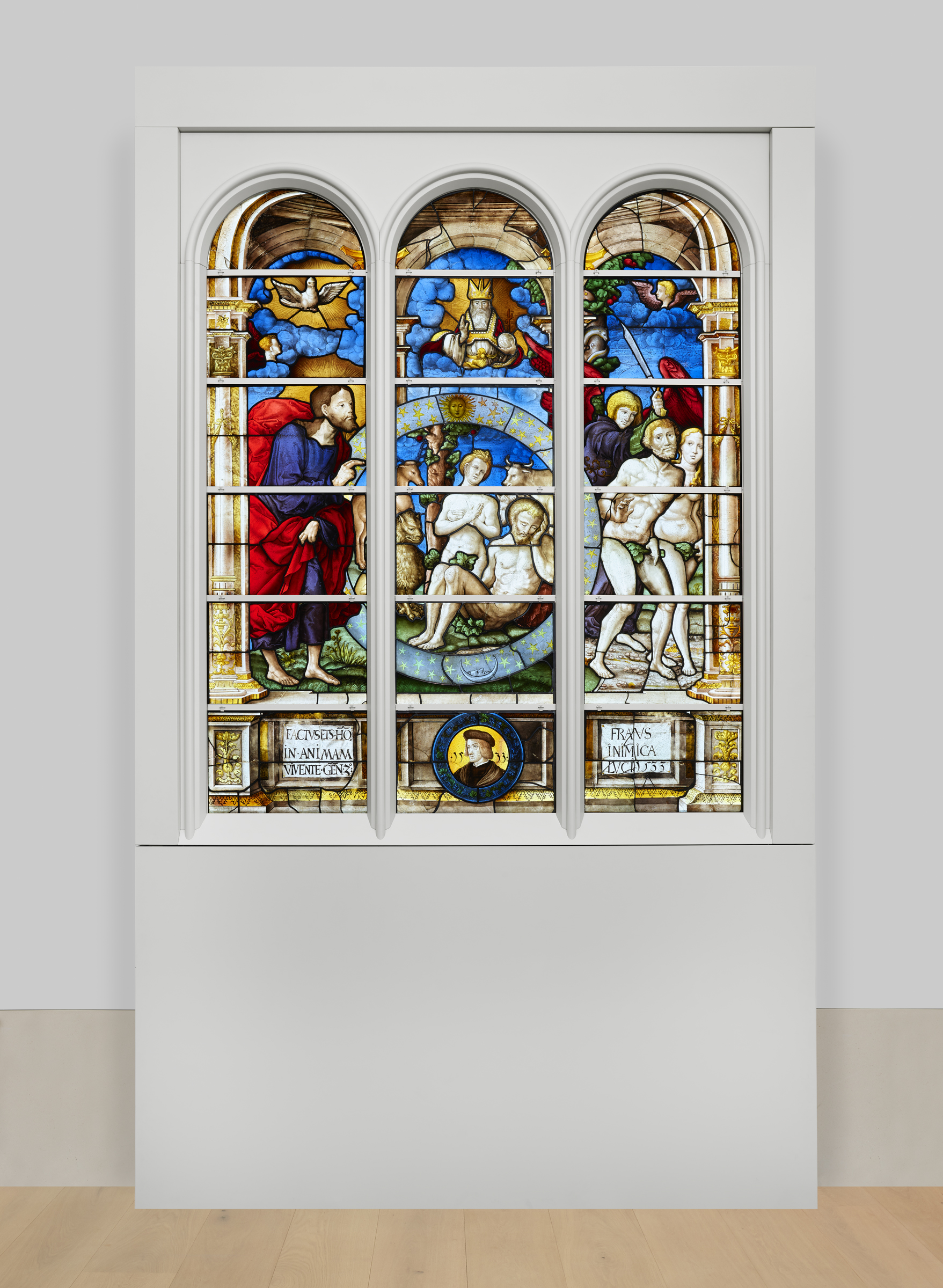Learn about new Hill Art Foundation exhibitions, events, publications, and much more!
Virtual ExhibitionValentin Bousch, The Creation and the Expulsion From Paradise
The Creation and the Expulsion from Paradise (1533) is a 16th-century stained glass window created by Valentin Bousch, one of the most prominent stained glass artists of the time. The window reads as a single narrative spanning across the three lancets. From left to right, the work depicts Jesus Christ blessing the creation of the world, Adam and Eve in the Garden of Eden, and the expulsion of the couple after tasting the forbidden fruit. The Creation and Expulsion window is one of four surviving windows by Valentin Bousch. Of the other three, two are on display at the Met Museum, and one is installed in St. Joseph’s Church in Stockbridge, MA. All four windows would have originally been displayed as part of a cycle of seven windows in the Saint-Firmin church in Flavigny-sur-Moselle.
The Creation and Expulsion window was acquired by Janine and Tom Hill in 2018 for the Hill Art Foundation. The stained glass has undergone extensive conservation under the leadership of Drew Anderson and Timothy Husband at the Metropolitan Museum of Art. It is permanently installed at the Foundation and will be incorporated into future exhibitions to create a rich web of juxtapositions. The Creation and Expulsion window was unveiled in 2023 as a part of the exhibition Lux and Lumen: Spencer Finch. The title of that exhibition references the ideas of Abbot Suger (1081–1115), who was the abbot of the Cathedral at Saint-Denis and an early supporter of the style of Gothic architecture throughout Europe. Suger believed stained glass was incredibly powerful in that it had the ability to change natural light, lux, into sacred light, lumen. The show made a connection between Suger’s philosophy, Valentin’s window, and Finch’s contemporary exploration of the spirituality inherent in all light.
This virtual exhibition provides specific conservation details alongside a breakdown of the iconography of the Creation and Expulsion window. The text is adapted from writing by Timothy Husband and Drew Anderson, with additional writing by Pingting Tu, Olivia Fountain, and Astrid Hill.
All four extant Valentin windows from Saint-Firmin have some key details in common. Each has the donor’s motto, “fraud the enemy of light,” transcribed in Latin in a bottom panel. The three smaller Valentins at the Met and St. Joseph’s place the motto at the middle bottom, while the Hill Valentin has it in the lower right. The St. Joseph’s Valentin (left) is displayed with three bottom panels bearing the letters F I L; these are in reference to the first initials of the de Lucy motto. Similar panels would have been displayed below the two Met windows, though those panes are kept in storage for the current display. All four windows also incorporate Latin scripture into the bottom section, making explicit the relationship between biblical text and the image cycle. For more context on this Catholic artist working at the dawn of the Reformation, read the excerpt from Timothy Husband’s essay below:
The circumstances under which Valentin came to Lorraine are not documented, but the stirrings of reformist sentiment in Strasbourg and Alsace may well have played a role. By 1520, the writings of Martin Luther (1483–1546) were widely circulating, and theologians such as Martin Bucer (1491–1551) promoted reformist thought in Strasbourg. The next few years saw incidents of civic unrest, including violent outbreaks of iconoclasm. Sensing the oncoming storm and an environment hostile to ecclesiastical commissions, Valentin and many other artists began to look for work in regions that sought moderate reforms rather than a complete rejection of Catholicism. Lorraine lay between the more radical teachings of Martin Luther in Strasbourg and the Germanic territories and the humanist movements in France. François I was initially receptive to reformist thought, though the aristocracy remained Catholic. Both Saint-Nicolas-de-Port and Metz had active Protestant communities. In Metz, a circle of humanists gathered and read Luther, Jacques Lefèvre d’Étaples (ca. 1455–1537), and Erasmus of Rotterdam (1466–1536), among others. Although the cadres of reformists never attracted a large following, the civic authorities nonetheless prosecuted them in the 1520s, sometimes violently. Lefèvre d’Étaples, who early on enjoyed the support of François I, sought to reform the Church without leaving it and was more in line with moderates such as Erasmus and Bucer. In the early 1530s, there was still belief within these moderate circles that the more flagrant excesses of the Church could be reformed and the Church itself reinvigorated through a reexamination of the Scriptures through original texts.



